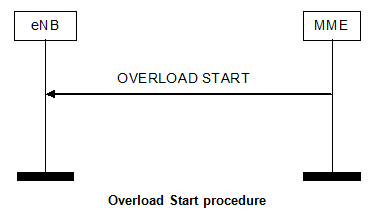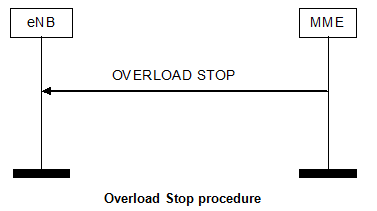Overload Start
The purpose of the Overload Start procedure is to inform an eNB to reduce the signalling load towards the concerned MME.
The procedure uses non-UE associated signalling.
Succesful Operation:

The eNB receiving the OVERLOAD START message shall assume the MME from which it receives the message as being in an overloaded state.
If the Overload Action IE in the Overload Response IE within the OVERLOAD START message is set to:
“reject RRC connection establishments for non-emergency mobile originated data transfer” (i.e., reject traffic corresponding to RRC cause “mo-data” and “delayTolerantAccess”
“reject RRC connection establishments for signalling” (i.e., reject traffic corresponding to RRC cause “mo-data”, “mo-signalling” and “delayTolerantAccess”
“only permit RRC connection establishments for emergency sessions and mobile terminated services” (i.e., only permit traffic corresponding to RRC cause “emergency” and “mt-Access”
“only permit RRC connection establishments for high priority sessions and mobile terminated services” (i.e., only permit traffic corresponding to RRC cause “highPriorityAccess” and “mt-Access”
“reject only RRC connection establishment for delay tolerant access” (i.e., only reject traffic corresponding to RRC cause “delayTolerantAccess”
the eNB shall:
if the Traffic Load Reduction Indication IE is included in the OVERLOAD START message and, if supported, reduce the signalling traffic indicated as to be rejected by the indicated percentage,
otherwise ensure that only the signalling traffic not indicated as to be rejected is sent to the MME.
NOTE: When the Overload Action IE is set to “only permit RRC connection establishments for emergency sessions and mobile terminated services”, emergency calls with RRC cause “highPriorityAccess” from high priority users are rejected.
If the GUMMEI List IE is present, the eNB shall, if supported, use this information to identify to which traffic the above defined rejections shall be applied.
If an overload action is ongoing and the eNB receives a further OVERLOAD START message, the eNB shall replace the ongoing overload action with the newly requested one.
Overload Stop:
The purpose of the Overload Stop procedure is to signal to an eNB the MME is connected to that the overload situation at the MME has ended and normal operation shall resume.
The procedure uses non-UE associated signalling.
The eNB receiving the OVERLOAD STOP message shall assume that the overload situation at the MME from which it receives the message has ended and shall resume normal operation towards this MME.
If the GUMMEI List IE is present, the eNB shall, if supported, use this information to identify which traffic to cease rejecting. If no particular overload action is ongoing for a particular GUMMEI value, the eNB shall ignore this value.
Successful Operation:

Reference TS 36.413 (8.7.6 and 8.7.7)
